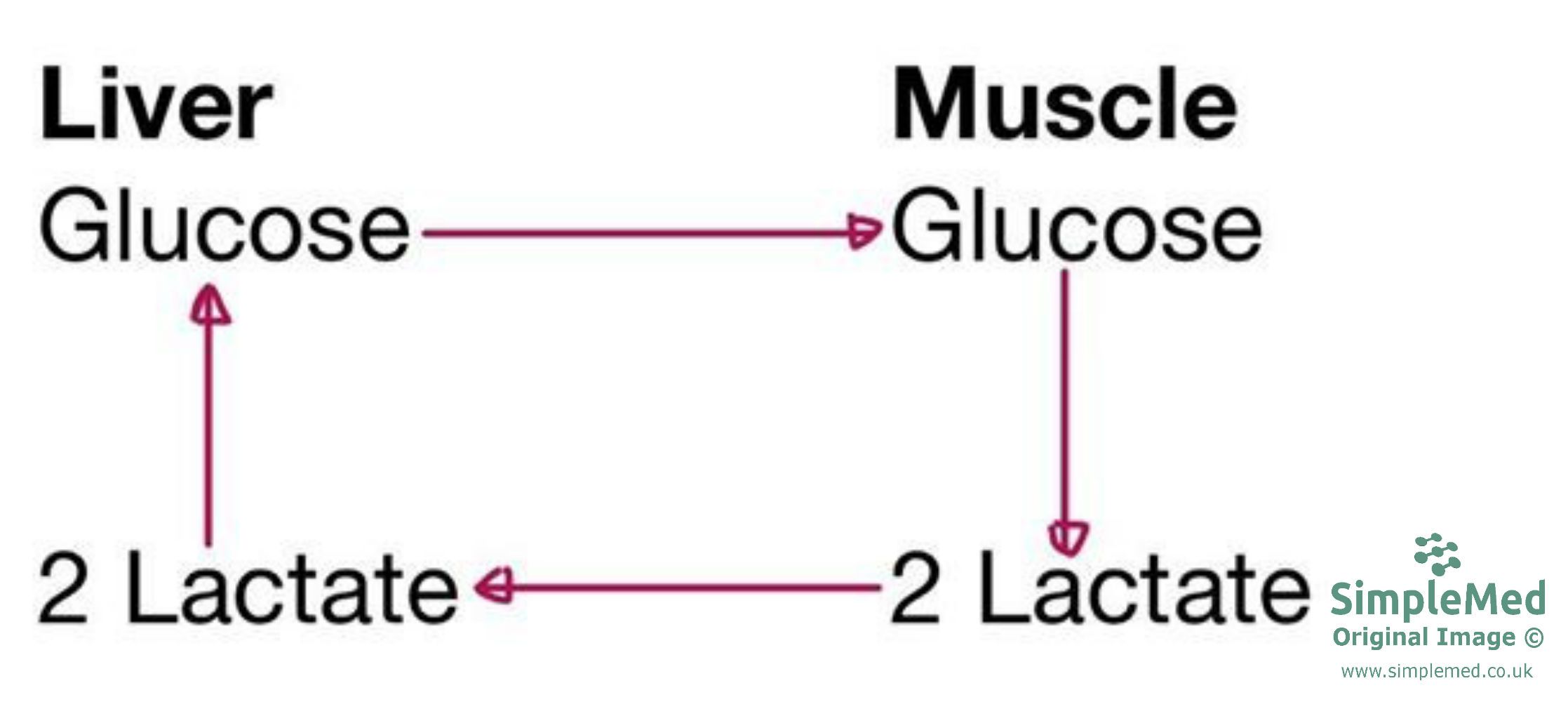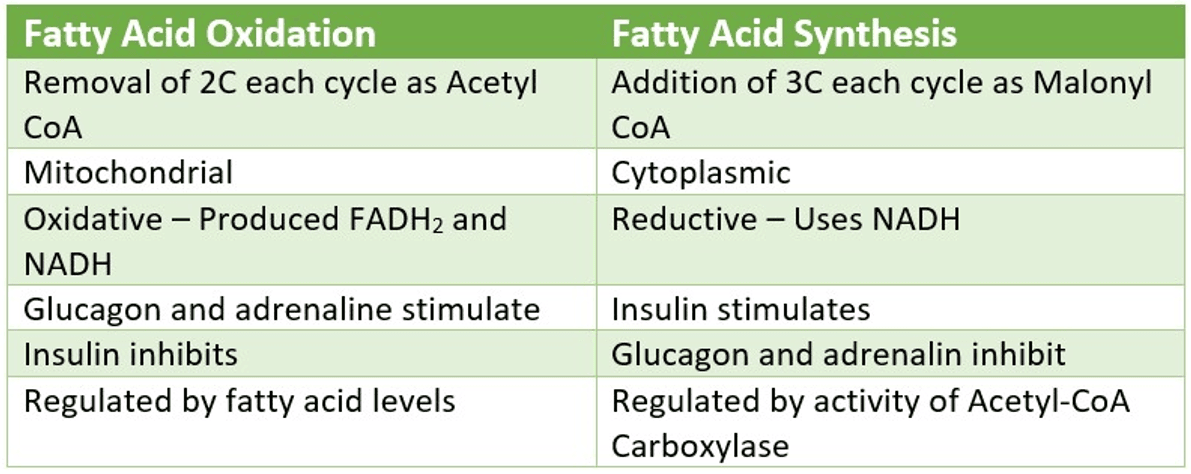Questions by Bethany Turner
Next Lesson - Temperature Regulation
Abstract
- Glucose is the ideal fuel for all cells in the body. This means that the body must store as much glucose as it can and be able to liberate it quickly when needed. Glucose is stored in the body as glycogen, which is formed through glycogenesis and released through glycogenolysis.
- Gluconeogenesis is the process through which glucose is produced from non-glucose sources like amino acids, lactate or glycerol.
- Fatty acid synthesis is a method of storing Acetyl CoA as Malonyl CoA 5p so they can be stored in adipose tissue for use when blood glucose levels fall.
- Storage of molecules used in energy production is under hormonal control: glucagon, adrenaline and insulin all influence the storage of fatty acids and glycogen.
Core
Glucose is the preferred fuel for all cells in the body, but most cells can metabolise other things such as ketone bodies if only a small amount of glucose is available. Some cells have an absolute requirement for glucose as they cannot metabolise any other energy source. Examples of these cells include: red blood cells, neutrophils, kidney medulla cells, and cells in the lens of the eye. Stable glucose levels are also needed for normal brain function, but the brain can use ketone bodies as an energy source if it absolutely must.
Normal blood glucose concentration = 4.0-6.0 mmol/L.
Renal threshold = 10 mmol/L. This is the maximum amount of glucose that the body can handle before the kidney can no longer reabsorb glucose, and appears in the urine. Renal threshold can be altered by physiological state (e.g. pregnancy) and other factors such as age.
N.B. reference ranges can vary between textbooks and trusts. In practice and written exams always use the reference values provided.

Diagram - The chemical structures of glycogen as well as the α1-4 and the α1-6 glycosidic bonds
SimpleMed original by Maddie Swannack
Glycogen is a molecule used to store glucose in cells. It is formed from chains of glucose molecules, linked into straight chains by α1-4 glycosidic bonds. Glycogen has a highly branched structure formed by α1-6 glycosidic bonds. These branched chains clump together to form granules inside certain cells, acting as a store of glucose.
These stores are mostly contained in cells of skeletal muscles and the liver. 100mg of glycogen is stored in the liver and can be used to raise the blood concentration of glucose. The 300mg of glycogen stored in muscles cannot be released into the blood and can only be used by the muscle itself. The liver can release glycogen into the blood as glucose as it possesses an important enzyme called Glucose-6-Phosphatase.
Glycogen storage diseases are a rare group of diseases that involve a deficiency in an enzyme involved in glycogen storage.
Too much glycogen storage can damage tissues and can occur if the cells are unable to break down the glycogen.
Too little glycogen storage causes chronic hypoglycaemia and poor exercise tolerance because there is no glycogen in storage that can be used to raise blood glucose levels. One example is von Gierke’s Disease, where no glycogen can be stored.
Glycogenesis is the process of turning glucose into glycogen. It occurs through four reactions, two of which are active, meaning that they require ATP to occur. These reactions add glucose onto the end of one of the strands of a glycogen molecule. Glucose can be:
- Added to an existing branch through glycogen synthase forming α1-4 glycosidic bonds,
- Or begin a new branch through branching enzyme forming α1-6 glycosidic bonds.

Diagram - The process of glycogenesis
SimpleMed original by Maddie Swannack
Glycogenolysis is the process through which glycogen is broken down into glucose, so that the glucose can be used for respiration.
There are two different enzymes needed to break the different types of glycosidic bonds present in glycogen:
- Glycogen phosphorylase breaks the α1-4 glycosidic bonds.
- Debranching enzyme breaks the α1-6 glycosidic bonds.
The glucose-6-phosphate produced here is then used in glycolysis in muscles, or if it is released by the liver, it can be used to raise blood glucose levels. This is because the liver possesses the enzyme Glucose-6-Phosphatase that is used to turn glucose-6-phosphate into glucose.

Diagram - The process of glycogenolysis
SimpleMed original by Maddie Swannack
Regulation of Glycogen Metabolism
Glycogen metabolism requires careful regulation to properly manage stores of glucose in the body. This is done through rate limiting enzymes, which are regulated by hormones.
Synthesis
Glycogen Synthase is the enzyme that is rate limiting in the synthesis of glycogen. Its action is inhibited by glucagon and adrenaline. This makes sense as glucagon is used to signal glycogen breakdown and adrenaline signals the fight or flight response meaning the body wants to increase the amount of glucose in the blood ready for use immediately rather than storing this glucose as glycogen.
Glycogen Synthase activity is activated in activity by insulin. This is because when insulin is released when blood glucose is very high (e.g. after a meal) and the glucose needs to be removed from the blood which can be done as storing it as glycogen.
Degradation
Glycogen Phosphorylase is the enzyme that is rate limiting in the degradation process of glycogen. Its action is activated when glucagon or adrenaline are released.
Glycogen Phosphorylase action is inhibited by insulin release.
Muscle Glycogen
Glycogen stored in muscles does not respond to glucagon, because glucose produced from the breakdown of muscle glycogen cannot be used to raise blood glucose. In the muscle adenosine monophosphate (AMP) is used instead of glucagon as the allosteric activator of Glycogen Phosphorylase. This means that when there are many AMP molecules in the muscle, glucose is released to allow for the production and release of ATP.
Gluconeogenesis is the production of new glucose from an originally non-glucose source; the three most common sources are amino acids, lactate and glycerol. This occurs after 8 hours of fasting, when glycogen stores are being depleted and a new source of glucose is needed. It occurs mainly in the liver, but also in the kidney cortex.

Diagram - This diagram shows the Cori Cycle. This is the cycle between the muscle using up glucose in anaerobic respiration to produce lactate, which then travels to the liver and, through gluconeogenesis, is turned back into glucose
SimpleMed original by Maddie Swannack
Key enzymes that are involved are PEPCK (phosphoenolpyruvate carboxykinase) and Fructose 1,6-bisphosphate (which are both regulated) and Glucose-6-Phosphatase (which is not regulated).
The regulated enzymes have their actions increased by glucagon and adrenaline because the body needs to create glucose in times of starvation or stress, and decreased by insulin because the body does not need to create glucose when blood glucose is high.
Triacylglycerols are highly efficient storage molecules. For more information on this and fatty acid oxidation, please go to our Lipid Metabolism and Transport article.
For more information about Fatty Acid oxidation, check out our Lipid Metabolism and Transport article.
Fatty acid synthesis occurs mainly in the liver. The enzyme Acetyl-CoA Carboxylase produces malonyl CoA (a 3 Carbon [3C] molecule) from Acetyl CoA (2C). Next the Fatty Acid Synthase Complex builds fatty acids using malonyl CoA as a monomer. This process requires ATP and NADPH to occur.
This process of fatty acid synthesis is increased by insulin. This is as when there is an increased amount of blood glucose available for metabolism (e.g. following a meal), there is also an increase in Acetyl CoA which can be stored as fatty acids. Citrate also increases synthesis as when there are high levels of citrate, it means that the Krebs Cycle cannot be completed fast enough. Therefore, the key ingredient from the link reaction which is Acetyl CoA, will build up as it cannot enter the cycle so is instead stored as fatty acid.
This process is decreased by glucagon and adrenaline. When these hormones are released, Acetyl CoA in the blood needs to be available for the oxygen dependent pathway in respiration to produce more ATP. This also explains why the process us decreased by AMP as well, as with high concentrations of AMP, the Acetyl CoA needs to go through respiration rather than be stored as fatty acids.

Table - The differences between fatty acid oxidation and fatty acid synthesis
SimpleMed original by Maddie Swannack
Blood glucose levels should remain around 4-6 mmol/L maintained by the balance of glycogenesis, glycogenolysis and gluconeogenesis. If blood glucose is not maintained, acidosis occurs.
To test the ability of the body to maintain its own blood glucose levels, an oral glucose tolerance test can be performed. This involves instructing a patient to fast putting their body into starvation and then assessing the concentrations of metabolites like glucose, lactate, pyruvate and ketones, as well as measuring pH. The patient should then be given a oral bolus of a known quantity of glucose and these values should be checked again at timed intervals to check their response.
This table summarises the influences of insulin and glucagon/adrenaline on fatty acid synthesis and glycogen storage or breakdown.

Table - The influences of insulin and glucagon/adrenaline on energy storage
SimpleMed original by Maddie Swannack
Edited by: Dr. Ben Appleby
Reviewed by: Dr. Thomas Burnell
- 7189

